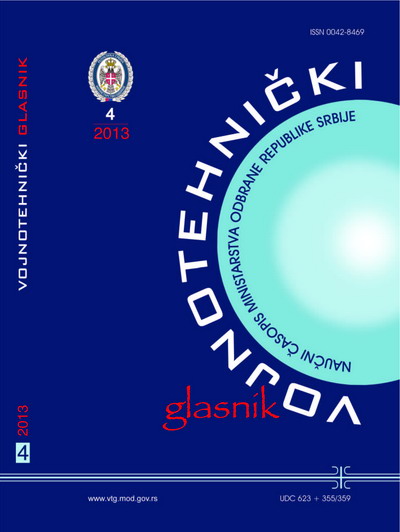Characterization of vacuum plasma sprayed cobalt - nickel- chromium - aluminum - yttrium coatings
Abstract
This paper analyzes the influence of the plasma spray distance on the microstructure and the mechanical properties of the Co32Ni21Cr8Al0.5Y coatings deposited with the vacuum plasma spraying (VPS) procedure. The microstructure and the mechanical properties of the plasma spray coatings were determined by the interaction of the Ar/H2 plasma ions with the powder particles when the transfer of the speed and temperature of ions on the powder particles occurs. The effect of interaction directly depends on the time of the interaction between ions and powder particles, which is defined by the plasma spraying distance. The powder is deposited by the plasma gun F4 at three substrate distances: 270, 295 and 320 mm. The coating with the best structural and mechanical properties was tested on the oxidation in a furnace for heat treatment without protective atmosphere at 1100°C in a period of 240 hours. The morphology of the powder particles was examined on the SEM. The microstructure of the layers in the deposited condition was tested by light microscopy. The coating with the best mechanical properties was electrolytically etched with 10% oxalic acid solution H2C2O4x2H2O. The analysis of the microstructure of the etched coating was performed by light microscopy and on the SEM, before and after testing the coating on oxidation. The microstructural analysis of the deposited layers was performed in accordance with the ’Pratt-Whitney’ standard. The mechanical properties of the layers were assessed through the examination of microhardness by the HV0.3 method and through bond strength tensile testing.
References
Achar, D.R.G., Munoz-Arroyo, R., Singheiser, L. and Quadakkers, W.J., 2004, Modelling of phase equilibria in MCrAlY coating systems, Surface and Coatings Technology, 187(2-3), pp.272-283.
Bose, S., 2007, High temperature coatings, Elsevier, Amsterdam.
Brandl, W., Toma, D. and Grabke, H.J., 1998, The characteristics of alumina scales formed on HVOF-sprayed MCrAlY coatings, Surface and Coatings Technology, 108 -109 (1-3), pp.10-15.
Czech, N., Schmitz, F. and Stamm, W., 1995, Microstructural analysis of the role of rehnium in advanced MCrAlY coatings, Surface & Coatings Technology, 76-77, pp.28-33.
Cheruvu, N.S., Chan, K.S. and Leverant, G.R., 2000, Cyclic Oxidation Behavior of Aluminide, Platinum Modified Aluminide, and MCrAlY Coatings on GTD-111, Journal of Engineering for Gas Turbines and Power, 122, pp.50 – 54.
Driver, L.C., 2004, HVOF spraying of WC-Co & MCrAlY coatings for aeroengine components, PhD thesis, Department of Mechanical, Materials and Manufacturing Engineering.
Feuerstein, A., Knapp, J., Taylor, T., Ashary, A., Bolcavage, A. and Hitchman, N., 2008, Technical and economical aspects of current thermal barrier coating systems for gas turbine engines by thermal spray and EBPVD: A review, Journal of Thermal Spray Technology, 17(2), pp.199 -213.
Gudmundsson, B., Jacobso, B.E., 1988, Structure formation and interdiffusion in vacuum plasma sprayed CoNiCrAlY coatings on IN738LC, Materials Science and Engineering, 100, pp.207-217.
Gurrappa, I., Sambasiva, A., 2006, Surface & Coatings Technology, 201, pp. 3016-3029.
Jiang, S.M., Li, H.Q., Ma, J., Xu, C.Z., Gong, J., Sun, C., 2010, Corrosion Science, 52, pp.2316-2322.
Leea, D.B., 2005, High-temperature oxidation of NiCrAlY/(ZrO2-Y2O3) and ZrO2-CeO2-Y2O3) composite coatings, Changhee Leeb a Center for Advanced Plasma Surface Technology, Sungkyunkwan University, Suwon 440-746, South Korea bDivision of Materials Science and Engineering, Hanyang University, Seoul 133 -791, South Korea Available online 21 September 2004, Surface & Coatings Technology 193, pp.239 - 242.
Material Product Data Sheet, 2011, Cobalt Nickel Chromium Aluminum Yttrium (CoNiCrAlY) Thermal Spray Powders, DSMTS – 0092.1, Sulzer Metco.
Mobarra, R., Jafari, A.H. and Karaminezhaad, M., 2006, Hot corrosion behavior of MCrAlY coatings on IN738LC, Surface and Coatings Technology, 201(6), pp. 2202-2207.
Mrdak, M., 2010, Uticaj brzine depozicije praha na mehaničke karakteristike i strukturu APS – NiCr/Al prevlake, Vojnotehnički glasnik / Military Technical Courier, 58(4), pp.5 -16.
Mrdak, M., 2012, Plasma deposited layers of nickel-chrome-aluminum-yttrium coatings resistant to oxidation and hot corrosion, Vojnotehnički glasnik / Military Technical Courier, 60(2), pp.182-201.
Nicholls, J.R.,and Bennett, M.J., 2000, Material at High Temperature,17(3) , pp 413-428.
Peng, X., and Wang, F., 2003, Morphologic investigation and growth of the alumina scale on magnetron-sputtered CoCrAlNCs with and without yttrium, Corrosion Science, 45(10), pp.2293-2306.
Poza, P. and Grant, P.S., 2006, Microstructure evolution of vacuum plasma sprayed CoNiCrAlY coatings after heat treatment and isothermal oxidation, Surface and Coatings Technology, 201(6), pp.2887-2896.
Prescott, R. and Graham, M.J., 1992, The formation of alumina oxide scales on high-temperature alloys, Oxidation of Metals, 38 (3 - 4), pp.233-254.
Tamarin, Y., 2002, Protective coatings for turbine blades, ASM International, Ohio.
Tang, F., Ajdelsztajn, L., Kim, G.E., Provenzano, V. and Schoenung , J.M., 2004, Effects of surface oxidation during HVOF processing on the primary stage oxidation of a CoNiCrAlY coating, Surface and Coatings Technology, 185 (2-3), pp.228-233.
Toscano, J., Vaen, R., Gil, A., Subanovic, M., Naumenko, D., Singheiser, L. and Quadakkers, W.J., 2006, Parameters affecting TGO growth and adherence on MCrAlY-bond coats for TBC's, Surface and Coatings Technology, 201(7), pp. 3906-3910.
Turbojet Engine – Standard Practices Manual (PN 582005)(2002),
Pratt & Whitney, East Hartford, USA.
Wang, B. and et al, 2002, Surface & Coatings Technology, 149, pp.70-75.
Proposed Creative Commons Copyright Notices
Proposed Policy for Military Technical Courier (Journals That Offer Open Access)
Authors who publish with this journal agree to the following terms:
Authors retain copyright and grant the journal right of first publication with the work simultaneously licensed under a Creative Commons Attribution License that allows others to share the work with an acknowledgement of the work's authorship and initial publication in this journal.
- Authors are able to enter into separate, additional contractual arrangements for the non-exclusive distribution of the journal's published version of the work (e.g., post it to an institutional repository or publish it in a book), with an acknowledgement of its initial publication in this journal.
- Authors are permitted and encouraged to post their work online (e.g., in institutional repositories or on their website) prior to and during the submission process, as it can lead to productive exchanges, as well as earlier and greater citation of published work (See The Effect of Open Access).

